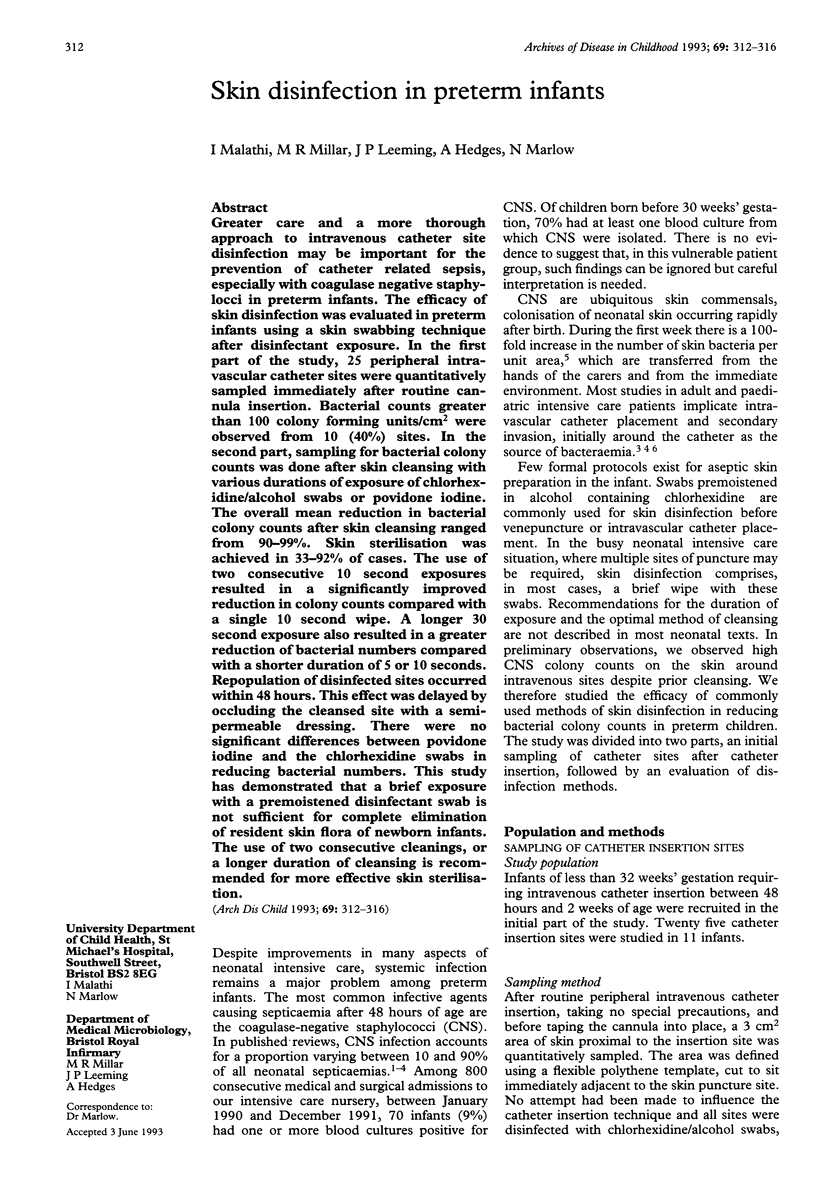Abstract
Greater care and a more thorough approach to intravenous catheter site disinfection may be important for the prevention of catheter related sepsis, especially with coagulase negative staphylocci in preterm infants. The efficacy of skin disinfection was evaluated in preterm infants using a skin swabbing technique after disinfectant exposure. In the first part of the study, 25 peripheral intravascular catheter sites were quantitatively sampled immediately after routine cannula insertion. Bacterial counts greater than 100 colony forming units/cm2 were observed from 10 (40%) sites. In the second part, sampling for bacterial colony counts was done after skin cleansing with various durations of exposure of chlorhexidine/alcohol swabs or povidone iodine. The overall mean reduction in bacterial colony counts after skin cleansing ranged from 90-99%. Skin sterilisation was achieved in 33-92% of cases. The use of two consecutive 10 second exposures resulted in a significantly improved reduction in colony counts compared with a single 10 second wipe. A longer 30 second exposure also resulted in a greater reduction of bacterial numbers compared with a shorter duration of 5 or 10 seconds. Repopulation of disinfected sites occurred within 48 hours. This effect was delayed by occluding the cleansed site with a semipermeable dressing. There were no significant differences between povidone iodine and the chlorhexidine swabs in reducing bacterial numbers. This study has demonstrated that a brief exposure with a premoistened disinfectant swab is not sufficient for complete elimination of resident skin flora of newborn infants. The use of two consecutive cleanings, or a longer duration of cleansing is recommended for more effective skin sterilisation.
Full text
PDF




Images in this article
Selected References
These references are in PubMed. This may not be the complete list of references from this article.
- Ayliffe G. A., Babb J. R., Davies J. G., Lilly H. A. Hand disinfection: a comparison of various agents in laboratory and ward studies. J Hosp Infect. 1988 Apr;11(3):226–243. doi: 10.1016/0195-6701(88)90101-6. [DOI] [PubMed] [Google Scholar]
- Choudhuri M., McQueen R., Inoue S., Gordon R. C. Efficiency of skin sterilization for a venipuncture with the use of commercially available alcohol or iodine pads. Am J Infect Control. 1990 Apr;18(2):82–85. doi: 10.1016/0196-6553(90)90086-8. [DOI] [PubMed] [Google Scholar]
- Donowitz L. G., Haley C. E., Gregory W. W., Wenzel R. P. Neonatal intensive care unit bacteremia: emergence of gram-positive bacteria as major pathogens. Am J Infect Control. 1987 Aug;15(4):141–147. doi: 10.1016/0196-6553(87)90137-4. [DOI] [PubMed] [Google Scholar]
- Fidalgo S., Vázquez F., Mendoza M. C., Pérez F., Méndez F. J. Bacteremia due to Staphylococcus epidermidis: microbiologic, epidemiologic, clinical, and prognostic features. Rev Infect Dis. 1990 May-Jun;12(3):520–528. doi: 10.1093/clinids/12.3.520. [DOI] [PubMed] [Google Scholar]
- Garland J. S., Dunne W. M., Jr, Havens P., Hintermeyer M., Bozzette M. A., Wincek J., Bromberger T., Seavers M. Peripheral intravenous catheter complications in critically ill children: a prospective study. Pediatrics. 1992 Jun;89(6 Pt 2):1145–1150. [PubMed] [Google Scholar]
- Hammerberg O., Bialkowska-Hobrzanska H., Gregson D., Potters H., Gopaul D., Reid D. Comparison of blood cultures with corresponding venipuncture site cultures of specimens from hospitalized premature neonates. J Pediatr. 1992 Jan;120(1):120–124. doi: 10.1016/s0022-3476(05)80614-6. [DOI] [PubMed] [Google Scholar]
- Hendley J. O., Ashe K. M. Effect of topical antimicrobial treatment on aerobic bacteria in the stratum corneum of human skin. Antimicrob Agents Chemother. 1991 Apr;35(4):627–631. doi: 10.1128/aac.35.4.627. [DOI] [PMC free article] [PubMed] [Google Scholar]
- Keyworth N., Millar M. R., Holland K. T. Development of cutaneous microflora in premature neonates. Arch Dis Child. 1992 Jul;67(7 Spec No):797–801. doi: 10.1136/adc.67.7_spec_no.797. [DOI] [PMC free article] [PubMed] [Google Scholar]
- Keyworth N., Millar M. R., Holland K. T. Swab-wash method for quantitation of cutaneous microflora. J Clin Microbiol. 1990 May;28(5):941–943. doi: 10.1128/jcm.28.5.941-943.1990. [DOI] [PMC free article] [PubMed] [Google Scholar]
- Maki D. G., Band J. D. A comparative study of polyantibiotic and iodophor ointments in prevention of vascular catheter-related infection. Am J Med. 1981 Mar;70(3):739–744. doi: 10.1016/0002-9343(81)90605-7. [DOI] [PubMed] [Google Scholar]
- Maki D. G., Ringer M., Alvarado C. J. Prospective randomised trial of povidone-iodine, alcohol, and chlorhexidine for prevention of infection associated with central venous and arterial catheters. Lancet. 1991 Aug 10;338(8763):339–343. doi: 10.1016/0140-6736(91)90479-9. [DOI] [PubMed] [Google Scholar]
- Maki D. G., Ringer M. Evaluation of dressing regimens for prevention of infection with peripheral intravenous catheters. Gauze, a transparent polyurethane dressing, and an iodophor-transparent dressing. JAMA. 1987 Nov 6;258(17):2396–2403. [PubMed] [Google Scholar]
- Sherertz R. J., Falk R. J., Huffman K. A., Thomann C. A., Mattern W. D. Infections associated with subclavian Uldall catheters. Arch Intern Med. 1983 Jan;143(1):52–56. [PubMed] [Google Scholar]
- Snydman D. R., Gorbea H. F., Pober B. R., Majka J. A., Murray S. A., Perry L. K. Predictive value of surveillance skin cultures in total-parenteral-nutrition-related infection. Lancet. 1982 Dec 18;2(8312):1385–1388. doi: 10.1016/s0140-6736(82)91281-8. [DOI] [PubMed] [Google Scholar]
- St Geme J. W., 3rd, Harris M. C. Coagulase-negative staphylococcal infection in the neonate. Clin Perinatol. 1991 Jun;18(2):281–302. [PubMed] [Google Scholar]
- Tager I. B., Ginsberg M. B., Ellis S. E., Walsh N. E., Dupont I., Simchen E., Faich G. A. An epidemiologic study of the risks associated with peripheral intravenous catheters. Am J Epidemiol. 1983 Dec;118(6):839–851. doi: 10.1093/oxfordjournals.aje.a113702. [DOI] [PubMed] [Google Scholar]



